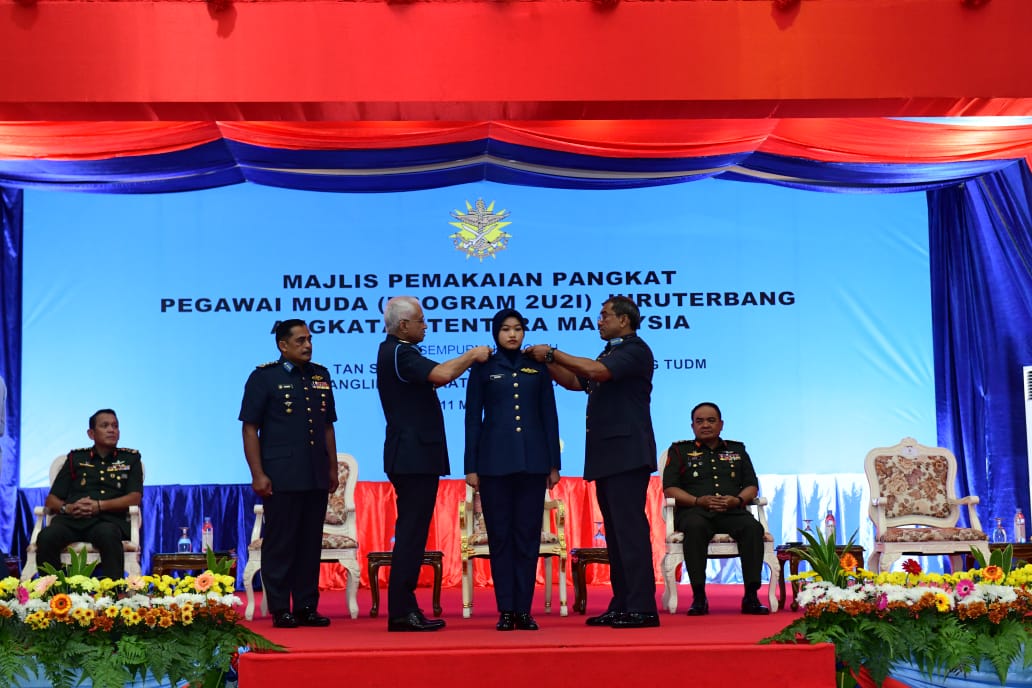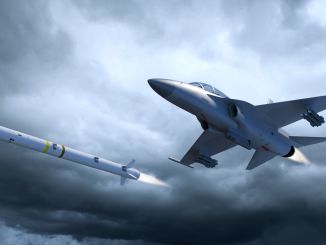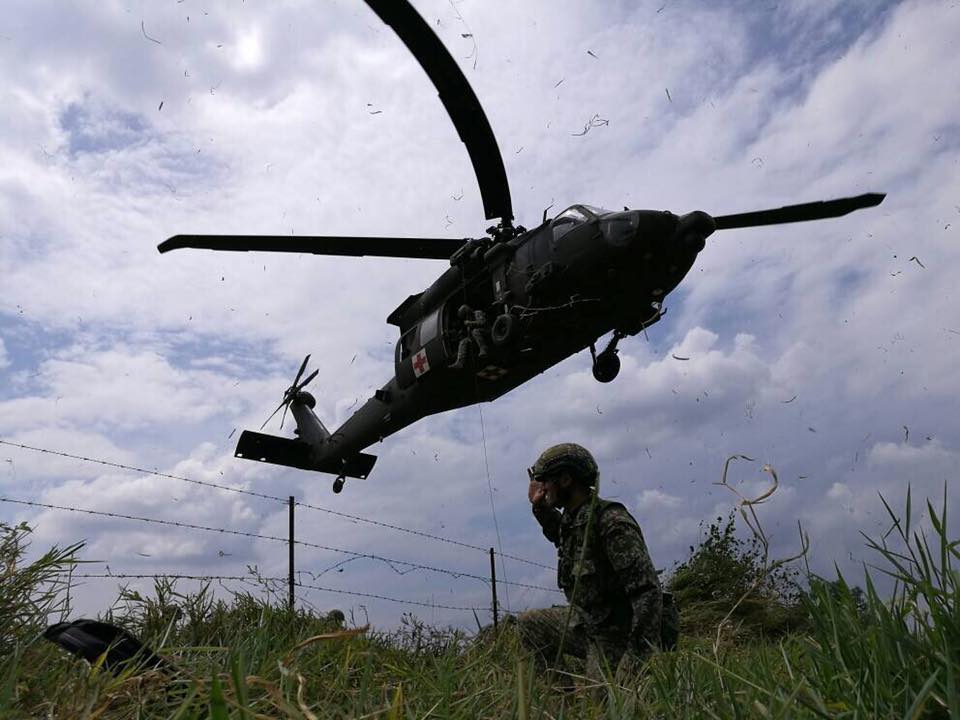
SHAH ALAM: Eighteen newly minted pilots have been commissioned into the Armed Forces in a ceremony held on the Perdana Camp in Sungei Besi, Kuala Lumpur on March 11. Malaysian Defence reported on their passing out parade from Kolej Tentera Udara last year. Fifteen of the newly commissioned pilots are from RMAF while the other three are from the Army. They are the first batch pilots who graduated via the Two -Year University- Two Year Industry (2U2I) programme.
Under the programme, announced in 2019 (though it started in 2018) between RMAF and Universiti Pertahanan Nasional Malaysia (UPNM), cadet officers selected for the Bachelor of Aviation will spend two years completing academic courses at the university. The undergraduates will then undergo flight theory and basic flight training for two more years at the KTU to obtain their flight wings. Once they graduated, they will be commissioned into the services as Leftenan Muda or Second Lieutenant.
𝗠𝗔𝗝𝗟𝗜𝗦 𝗣𝗘𝗠𝗔𝗞𝗔𝗜𝗔𝗡 𝗣𝗔𝗡𝗚𝗞𝗔𝗧 𝗣𝗘𝗚𝗔𝗪𝗔𝗜 𝗞𝗔𝗗𝗘𝗧 𝗔𝗡𝗚𝗞𝗔𝗧𝗔𝗡 𝗧𝗘𝗡𝗧𝗘𝗥𝗔 𝗠𝗔𝗟𝗔𝗬𝗦𝗜𝗔 (𝗔𝗧𝗠) (𝗣𝗥𝗢𝗚𝗥𝗔𝗠 𝟮𝗨𝟮𝗜) 𝗝𝗨𝗥𝗨𝗧𝗘𝗥𝗕𝗔𝗡𝗚 𝗧𝗔𝗛𝗨𝗡 𝟮𝟬𝟮𝟯
KUALA LUMPUR, 11 Mac 23 – Majlis pemakaian Pangkat Pegawai Kadet (PK) Angkatan Tentera Malaysia (ATM) (Program 2U2I) Juruterbang telah disempurnakan oleh Yang Berbahagia Jeneral Tan Sri Dato’ Sri Haji Affendi bin Buang TUDM, Panglima Angkatan Tentera (PAT) bertempat di Dewan Tun Templer Kem Perdana Sungai Besi.
Buat pertama kalinya dalam sejarah, seramai 18 Pegawai Kadet ATM yang terdiri daripada dua (2) cabang perkhidmatan iaitu Tentera Darat Malaysia (TDM) dan Tentera Udara Diraja Malaysia (TUDM) telah berjaya menamatkan Program Latihan PK 2U2I dan Majlis Pemakaian Sayap Penerbangan telah dilaksanakan oleh PTU di Kolej Tentera Udara (KTU) pada 17 Disember 2022. Pecahan Pegawai Muda (2U2I) Juruterbang ATM pada tahun ini bagi perkhidmatan TDM ialah tiga (3) orang lelaki manakala bagi TUDM ialah 14 orang lelaki dan seorang (1) wanita.
Terdahulu, program ini telah dilaksanakan mulai 13 Jul 18 hingga 7 Feb 21 di Universiti Pertahanan Nasional Malaysia (UPNM) bagi program 2U dengan LULUS Kepujian Kelas Kedua (Tinggi), Ijazah Sarjana Muda Penerbangan (ZK61). Seterusnya mulai 8 Februari 2021 hingga 17 Disember 2022, meneruskan latihan di Institut Penerbangan 1 dan Institut Penerbangan 2 (INSPEN 1 dan INSPEN 2) bagi program 2I. Bagi PK yang LULUS Kursus Asas Penerbangan (BFC) Siri 83/21 dan Kursus Asas Penerbangan Helikopter (BHFC) Siri 63/21, mereka seterusnya layak ditauliahkan sebagai Pegawai Muda ATM dengan pangkat Leftenan Muda.
Majlis ini merupakan satu pengiktirafan yang amat bermakna kepada ATM kerana berjaya melahirkan juruterbang muda melalui program Latihan 2U2I yang menggunakan kepakaran di peringkat TUDM.
As reported previously by Malaysian Defence:
The 2U2I programme is aimed in reducing the age of pilots entering MAF from the current twenty-six to twenty-three. Previously, newly commissioned officers – RMAF, Army and RMN – need to obtain a bachelor’s degree from UPNM or other universities before embarking on their flight training. This means by the time a pilot declared operational in the three services, they will be around thirty. Under the new programme, they will be around twenty-seven.
As previously reported, thirty-seven candidates started the programme in 2018 but only eighteen made through the flight school and commissioning to continue with their career in the military. With the Armed Forces moving into the unmanned aircraft business -the Anka and Scan Eagles for now – hopefully, those who washed out during the flight training could still serve in the aviation world as well.
— Malaysian Defence
If you like this post, buy me an espresso. Paypal Payment




I said it before, even if given a super high attrition rate of 1/3 (where newbies would leave the service or later unfit for flying), each academic year would still pump out 12 flying pilots yearly. In 5 years we’d have 60 new pilots for the Armed Forces, in 10 years we’d have 120 pilots, more than available crafts for them to pilot. For that we need to keep this program sustained on a year by year basis.
“I said it before”
Well of course you did.
“For that we need to keep this program sustained on a year by year basis;
You’ve just described the main challenge. Ensuring we maintain the numbers.
Even if one maintains the numbers there is the pertinent fact that out of the 12 pilots annually; a couple or so might later be found unsuitable for various reasons. Not only that but
due to transfers, people leaving and other reasons; the number of existing pilots does dwindle. 12 is the bare minimum we need annually and even that will be hard to be consistent with. Just to give you some idea; we use to have two training cycles per annum but years ago that was cut to one.
We can even go further and talk about techbical/support people who are a commodity and are in small numbers and not easy to replace. In short; due to various factors manpower will be a constant challenge; as any former and current serving RMAF servicemember will attest to.
“found unsuitable, due to transfers, people leaving and other reasons”
I already factored those into the high 1/3 attrition rate, will still left 12 full time pilots. Typical in any higher education the pioneer batch will be of smaller size and it will grow as the education program matures, so 12 is the baseline and more should come with each grad year.
Ground crew technical/vocational training are lesser demanding (thus fail less candidates) as compared to pilot school, this is the same in civvie aviation world which is why pilots are paid much better than senior ground staffs.
”it will grow as the education program matures, so 12 is the baseline and more should come with each grad year.”
The keyword is ”should” but as we’ve seen over the years; maintaining a certain number is extremely challenging. Even after the graduate; they can leave or be transferred.
I was buddies with an experienced CN-235 pilot who left because of a sinus issue and was acquainted with a Fulcrum pilot who was given a choice but left [ended up in the Gulf flying passenger jets] because of reasons won’t get into here. Then there are those who make it past FTC 1 and 2 but after a while are found unsuitable.
”Ground crew technical/vocational training are lesser demanding”
They are needed in large number than pilots; are time and resource extensive to train; aren’t available in numbers to begin with and aren’t easily replaceable. Quite often someone can leave the service and won’t be replaced for quite a while and if immediately replaced; not by someone with the same level of skills or experience.
If the program is kept sustained thru 5 years, 10 years, or more, the ever growing cohort of grads will supplant attritions from earlier batches of pilots. Yes, keyword is “should” if the Govt & ATM commits to maintaining this program.
“replaced; not by someone with the same level of skills or experience.”
That is common in any employment field, even bengkels bawah pokok faces it. That is life. But to hire & train a ground staff is obvious lesser requirement, less intensive, less time & resource consuming, less technically challenging, & less likely to flunk, than pilot school.
”Yes, keyword is “should” if the Govt & ATM commits to maintaining this program.”
Not whether they ”commits to maintaining this program” but whether the number can be maintained; in addition a host of other dynamics. BTW there have been other programmes in the past but they didn’t work out and not because of commitment issues on the part of the government or RMAF,
”But to hire & train a ground staff is obvious lesser requirement, less intensive, less time & resource consuming,”
Takes time for people to gain experience and before they leave it takes them for them to impart their experience. I wouldn’t underestimate the value or the challenges in getting the often overestimated and undervalued tech/engineering people …
“but whether the number can be maintained”
Depends on how well the program is received by prospective candidates. Being a pilot still is quite a popular thing but only the creme of the crop would actually make it to pilot school. A popular program would able to attract more & more candidates to join up but if they screwed it and gets a bad impression then candidates would not want to join even if they have a chance, or they might join other Armed Forces aviation programs. We’ll need to see in few years how it pans out and where its heading.
“I wouldn’t underestimate the value or the challenges”
Neither do I and I deal with them on a daily basis, but people do come & go, which is why HR would always provision 1/3 headcount as attrition management. Thats life. How soon they can be of use depends on how well the training program are setup & they could learn from, how much they could learn from seniors and poring thru work documentation, and gaining new experience along the way which they should impart to new joiners. The credentials and motivation of candidates to join up also matters as much & how they will last in their careers, things that ATM could not control nor predict but could try preempt by whittling down half past sixes.
“Being a pilot still is quite a popular thing but only the creme of the crop would actually make it to pilot school”
To begin with we only induct a limited number annually. Of that only a portion make it to FTC1 and are in turn streamed to fast jets, transports and rotary. From there a number will be found unsuitable for flying and will be transfered out. A smaller number might even leave the service prematurely. Some gain the needed experience but after a while as part of their career progression move up the ladder and cease flying.
“We’ll need to see in few years how it pans out and where its heading”
Yes but I’m not sanguine given we’ve launched other programmes before and that there are inherent obstacles in the way.
“Neither do I and I deal with them on a daily basis”
I don’t deal with them on a daily basis; never did and never will. From conversations with friends and acquaintances however I do know the immense problems/challenges we face and that the situation in civvie street differs greatly to that in the services. The manpower may be there but retaining and replacing skilled and experience people who do things which require a level of skills is an entirely different matter. I won’t go more into specific actual issues that I’m aware of [Marhalim too will know stories]-but it’s worrying and is a major inhibitor.
“retaining and replacing skilled and experience people”
Skilled manpower are any time a precious resource in any industry or occupation and will invariably takes time to mature a replacement which depends on a robust & effective human resource strategy & programs.
I wont pretend to know what are those “specific actual issues” but it sounds like something more underlying deeper than just finding people to be interested. Retaining skilled members in ATM is common issue with all militaries as the pull of civvie work with the higher pay would be alluring to anyone.
Graduating just a little more than a dozen annually is too little for all 3 services.
Most aircraft such as transport, MPA and helicopters will need 2 pilots. Transport aircraft on long stints might even have 2 sets of crews on board.
Then there is UAVs. IMO any UAVs other than small quadcopter drones should be operated by certified pilots, to understand interactions with ATC and manned airplanes around them.
As of washout, currently we are using a quite complex and powerful aircraft, the PC-7 Mk2 for students to solo from. Previously we have the MD3-160 as a basic trainer. A simpler aircraft should also have a much lower operating cost than the PC-7 Mk2.
Probably we should have
– basic training in a more docile prop trainer, something like the MD3-160 but much modern fuel efficient engines and instrumentation (such as Garmin touchscreen MFDs). To learn basic flying, VFR, IFR, long range navigation, advanced glass cockpit procedures. This should lead to more passes to get their basic wings aka comissioned.
– after that, trainee pilots would be filtered to 4 streams: fighter, transport, helicopter, UAVs. Fighters will continue with PC-7 Mk2 Inspen 1 and later to FLIT, transport to PLTT, helicopter to Inspen 2 & UAVs to a dedicated UAV training unit/center. Anyone that washes out of fighter and helicopter training would be offered UAV posts.
Hulubalang … – ”IMO any UAVs other than small quadcopter drones should be operated by certified pilots, to understand interactions with ATC and manned airplanes around them.”
For the RMAF yes but then the RMAF will not operate anything other than a fixed wing unmanned asset. Fixed wing unmanned assets operated by the RMN and army do not have to be operated by certified pilots.
Azlan,
I believe that any UAV that can fly for more than half a day and at ranges hundreds of km from the operator, needs to have an operator that is a certified pilot.
Regarding to dedicated UAV training unit, TNI-AU just in recent days has designated its SKADIK 103 as a dedicated UAV training unit.
… hulubalang – ”I believe that any UAV that can fly for more than half a day and at ranges hundreds of km from the operator”
What you believe is what you believe but there is no need for tactical or operational level [as opposed to your ”any UAV that can fly for more than half a day and at ranges hundreds of km from the operator”] UASs to be operated by certified pilots; if there were there would be a training backlog of pilots stretching years….
… Hulubalang – ”TNI-AU just in recent days has designated its SKADIK 103 as a dedicated UAV training unit.”
As mentioned before; due to certain inadequacies the RMAF will operate a MALE but as we matures as a UAS operator it behooves to operate all MALES under a tri service ”UAS Command” in order to fully maximise what we have; to avoid any issues regarding tri service friction/bureaucracy and to ensure jointness.
Azlan,
Certified as a pilot ≠ competent fighter pilot
You can be trained to be a basic pilot for 2-3 months and then move on to flying UAVs.
It not just the knowledge of flying an aircraft. Being a pilot you also learn about radio interactions with ATC, air traffic procedures and separation with other aircrafts, and also air traffic laws in regards to Malaysia Civil Aviation Regulations (MCAR) Reg 140. It may not be critical for quadcopters flown within line of sight, but it should be important for large UAVs with medium range and long endurances that fly in airspaces occupied by manned aircraft.
… Hulubalang – “Certified as a pilot ≠ competent fighter pilot”
Thanks for the update but as I said; there is absolutely no reason for tactical UAS [not confined to “quadcopters”] operators to be certified pilots; if there were the training backlog would span years. That is the point I was driving at from my first post on the subject …